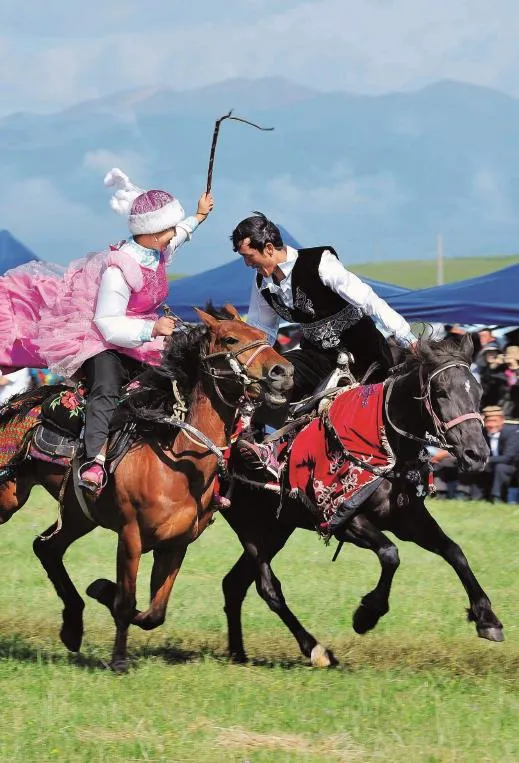Xinjiang Culture Goes Global
By Zhang Yan
Xinjiang Culture Goes Global
By Zhang Yan

A traditional sport on horses called“chased by a girl.” Xinjiang boasts hundreds of traditional sports. (Photo by Yu Xiangjun)
Abudu Rahaman, a reporter from Mauritania, visited Xinjiang earlier this year, together with other foreign journalists working in China. “This is my first trip to Xinjiang and I am deeply impressed by its abundant historical sites and cultural atmosphere,” said Abudu Rahaman, who now works for the China Radio International (CRI).
“People in Xinjiang share similar dietary habits and clothing styles with Arab countries, which makes me feel at home,” he said.“Many ethnic groups live in Xinjiang and the harmonious communication with each other impressed me.”
Located in the western frontier of China and central Eurasia, Xinjiang is a quintessential part of the ancient Silk Road and bridges China to the rest of the world. However, few people know of Xinjiang, and the region should learn to promote itself, especially in today's era of globalization.
Embracing the world through dance
A symbol of change, innovation and vigor, dance serves as a channel for the communication and integration of diferent cultures. The Xinjiang International Dance Festival forged a peace and friendship bridge through art and developed an international reputation.
This year marks the third Xinjiang International Dance Festival. Te festival has always upheld the principle of “Chinese style,Xinjiang characteristics and international standard.” Various dance performances including Swan Lake, Red Detachment of Women, Raise the Red Lantern, Spring of Muqam and A Lovely Rose were staged during the festival, with each artistic piece touching the hearts of audience in its own way.
During the festival, over a thousand dancers of various ethnic backgrounds,speaking different languages and from different continents, communicated with each other through the universal language of dance, overcoming national diferences andcultural barriers. Te world is a colorful one,so should art be.
“Xinjiang artists used to have few opportunities to go outside the region to perform,thus they knew little about the world's latest performance trends,” said Wang Shusheng,a former director of the opening ceremony of the Xinjiang International Dance Festival.“After thoroughly communicating with artistic troupes from around the globe during the festival, performance groups in Xinjiang are now endeavoring to change, no matter whether performing classic dances or creating new dances. More modern technologies have been applied to create the best audio and visual efects for audiences, making the show more modern and more international.”
In recent years, Xinjiang has shared its culture to the world through artistic performance, multi-language book publications and sports events. Concurrently, Xinjiang has absorbed aspects of other cultures and developed itself through constant innovation. But in order for the world to learn more about Xinjiang and share in its splendid culture,Xinjiang must do more to promote itself.

A Kyrgyzstan reporter plays a traditional musical instrument with local elders. Situated along the Silk Road, Xinjiang has been a bridge connecting cultures and peoples since ancient times. (Photo by Xu Hao)
Building a new silk road with books
During the seventh Silk Road International Book Fair held in Alma-Ata,capital of Kazakhstan, a series of books about the culture and history of Xinjiang written in Kazakhstan Cyrillic were on display, creating enormous interest among the public. Those books include Xinjiang on the Silk Road, A Big Family of China's Ethnic Groups and Tirteen Original Ethnic Groups in Xinjiang. At the fair, Xinjiang publishers exhibited 300 locally produced titles, which included books written in Kazak, Uygur, Kirgiz, English,Russian and Chinese languages, to meet the needs for copyright trade with Central Asian countries. Those Xinjiang books will be sold in stores and supermarkets across Kazakhstan afer the book fair.
After Xinjiang's publishing industry implemented the “go global” strategy, more and more publishing companies have been making great eforts in exploring the international market. “We used to sell the copyrights to our books to outside publishers, with which we had little cooperation. Today, we are cooperating more with publishing companies outside Xinjiang, which has helped raise our publication quality to new heights,”said Yu Wensheng, President of the Xinjiang Fine Art Photography Publishing House.“Once the ‘go global' strategy has a clear direction, it's only a matter of time before the region's sof power is enhanced.”
As of the end of 2012, Xinjiang had given over 720,000 copies of magazines, including such titles as Good Neighbors and Land Bridge, and 80,000 books to neighboring countries for free. At the same time, Xinjiang has purchased copyrights to 300 titles of books from abroad. While promoting its history, culture, regional fair and economic achievements to the outside world through publications written in different languages,Xinjiang has done its part to meet the demands of local people to learn more about the world through the import of foreign books and the purchase of copyrighted materials. A modern silk road for cultural communication through books is now thriving.
Friendship through sports
Sport is a vital channel to boost communication between different countries. Xinjiang is perfectly situated in this regard due to its special geographic location. The region borders Kazakhstan and Kyrghyzstan and is adjacent to Uzbekistan and Turkmenistan and there are 10 ethnic groups living near the borders with Central Asia.
As a region clustered with many ethnic groups, Xinjiang is home to more than 100 traditional sports, such as horse racing,wrestling and acrobatics. Those sports have distinctive regional characteristics with rich cultural connotations. Te countries of Central Asia share a similarity in traditional sports with Xinjiang, and these countries have maintained constant exchanges and communication with the region, as a result.
Basketball, table tennis and mountain climbing games and events have also become quite common between Xinjiang and Central Asian countries. In terms of traditional sports like horse racing, Xinjiang ofen holds friendly matches with countries like Kazakhstan and Kyrghyzstan. While sustaining rituals and customs, traditional sports help support ongoing communication between diferent ethnic groups in Central Asia and promote peaceful living in the region.

